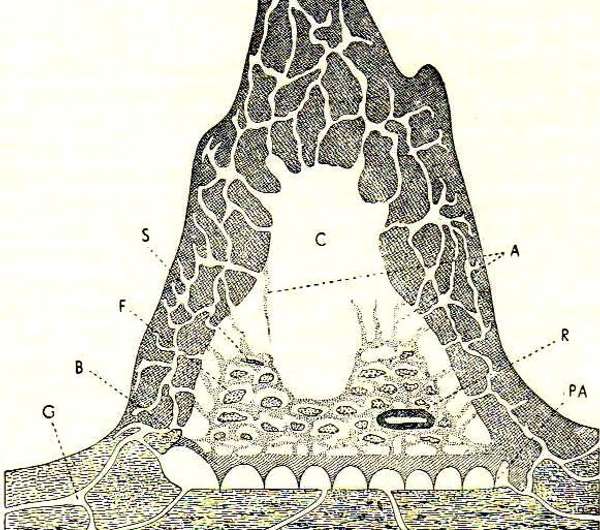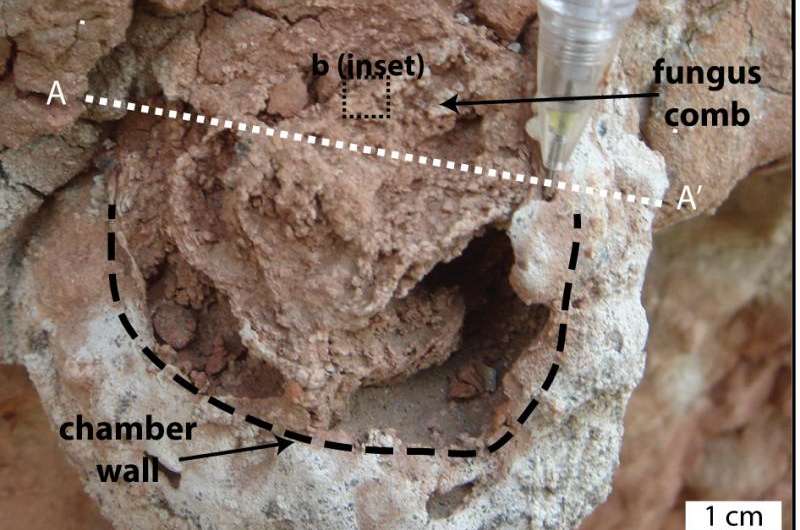Finding the first fungus farmers

The development of farming was a key milestone in human history, but as a species we were quite late to the party. Insects got there first! One of the best documented examples happens in the termite world, where some species "farm" fungus as a food source. Although many termites simply use their guts and gut bacteria to extract nutrients, an African group called macrotermitines grow fungus on excreted pellets of partly digested plant matter. The termites then eat these fungi, which provide a nice dose of more easily accessible goodies.
The evolution of insect behaviors such as these fascinates scientists, but is hard to reconstruct precisely. Studies of DNA can assemble the insect family tree, which in turn can suggest where and how many times certain behaviors appeared evolutionarily. But, in terms of figuring out when, fossils are critical. This reveals a double conundrum, though. First, insects are relatively soft-bodied and often do not preserve well in the fossil record. Second, traces of their behavior, such as nests, are also either poorly preserved, or else overlooked by paleontologists who might not recognize the structures.
So a recent PLOS ONE paper by Eric Roberts and colleagues provides some really nice evidence to clarify the evolution of fungal farming in termites. A series of fossils from ~24.5 million year old rocks in Tanzania show what is probably the oldest termite nests with fungal gardens yet published in detail. The previous indisputable record holder was around 7 million years old. Older occurrences are possible (~35 million years old), but are still uncertain due to poor preservation and less detailed published analyses.

The newly announced find is remarkable for its age, but even more remarkable for the structures preserved within it. Based on a series of analyses using multiple imaging techniques, the authors interpret the fossils as showing a fungus "comb" comparable to that seen in modern termite nests. This constrains the origin of fungal farming to ~25 million years ago at the very latest, and potentially much older. A helpful calibration point, hand-in-hand with evolutionary trees for termites based on DNA, suggests the ultimate origin of fungal farming by roughly 31 million years ago (give or take a few million years, due to uncertainty in estimates–future fossils may further refine the dating).
What does this date mean? First, it suggests that fungal farming happened not long before the modern group of farming termites had their evolutionary radiation, or maybe even at the same time. More interestingly, it is possible (even probable) that the origin of fungal farming occurred alongside the transition of the East African landscape from largely forested to a more open, grassy ecosystem. Did termites evolve farming to cope with a changing environment? It's too soon to tell, but perhaps the next discovery of fossil termite farms will provide clarification.
More information: Eric M. Roberts et al. Oligocene Termite Nests with In Situ Fungus Gardens from the Rukwa Rift Basin, Tanzania, Support a Paleogene African Origin for Insect Agriculture, PLOS ONE (2016). DOI: 10.1371/journal.pone.0156847
Journal information: PLoS ONE
Provided by Public Library of Science
This story is republished courtesy of PLOS Blogs: blogs.plos.org.




















